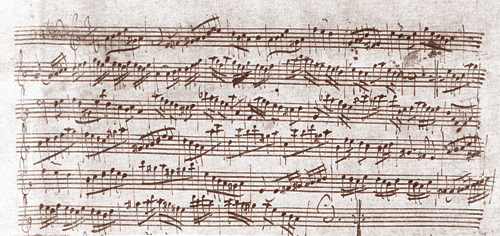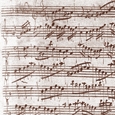As much as I would like to claim originality, virtually all of the following thoughts have been expressed previously by eminent music scholars. It can be difficult to alter aspects of music you have performed for years and may have learned from great teachers. If you open to change, however, there are different ways to play the classics of the flute repertoire that are closer to how the composers originally intended.
Bach: Partita in A Minor, BWV 1013
Let’s start with J.S. Bach and the case of the missing four measures. In measure 35 of the Partita in A Minor for solo flute, Sarabande, there is a problem in many editions. When it is time to restate the opening four-measure theme, like starting a second verse, various editions instead jump to the development, which is similar to the original development starting with the fifth measure from the beginning. It seems unlikely that Bach would state his theme at the beginning and never again. The only surviving manuscript is that of the copyist Bernhard Christian Kayser (1705-1758), who might have been momentarily distracted and turned a page too soon. At any rate, inserting the opening four bars restores the musical balance to the beautiful Sarabande.

Sarabande, Bars 35-40.
.jpg)
Chaminade: Concertino for Flute and Piano, Op. 107
When performing this piece, check www.imslp.org to study the first edition of the work which was published by Enoch & Cie in 1902. Many of the questions about possible note and dynamic mistakes found in modern reprints can be answered in this edition. For example, in modern reprints the F# grace in measure 145 should be an F double sharp to match measure 143. It was printed correctly in the first edition.
In the cadenza in the first edition the only dynamics printed are the two crescendo/diminuendo hairpins which occur on the final trill and the phrase just before. Around 1943, I studied with the marvelous teacher Mildred Hunt Wummer in New York City. She thought this grand cadenza should be performed in the manner of one of the big Romantic piano concertos. The F# major section should be forte and dramatic with a sharp cutoff on the F#6, and the next section in F# minor should be played like a distant echo with the final A7 fading away. Then it is time for brilliance again with the three arpeggios, perhaps playing the second one with a darker tone and returning to brilliance for the last one. If you see the logic of these dynamics, you will find a new excitement in this popular solo.
Chaminade Cadenza
.jpg)
Griffes: Poem
The Poem was written by Charles Tomlinson Griffes (1884-1920) in 1918 and first performed on November 16, 1919 by flutist Georges Barrère with the New York Symphony Orchestra, Walter Damrosch conducting. The work was published by G. Schirmer in 1922, edited by Barrère. The work is scored for solo flute, two horns, percussion, harp and strings.
In 1982 musicologist Donna K. Anderson learned that I was performing the Poem with the Syracuse Symphony Orchestra with guest conductor Jean-Pierre Rampal. She had been working on The Works of Charles T. Griffes: A Descriptive Catalogue (Ann Arbor, 1984) and arrived at my studio with a photocopy of the recently surfaced solo flute manuscript which she had obtained from a secretive owner in Spain. Her scholarship reports many discrepancies between the original manuscript and the Georges Barrère edited version. (See Flute Talk, March, 2004). For example at letter L, the slur starts on the B7, not at the beginning of the next bar. This enables the flutist to sing on those high notes and connect better with the main theme from the opening. After working with Anderson, it was marvelous to play the Griffes as the composer intended. Before performing the work, check the current scholarship on the composition for performance suggestions.
Griffes Poem
.jpg)
The Boehm Flute
There are other performance improvements which might make composers like Bach and Beethoven say thank you to modern flutists. We can certainly make use of the increased usable range of the Boehm flute. For instance there are numerous examples in the finale of the Bach Brandenburg Concerto No. 5 where the use of the low B foot makes musical lines flow more logically. For Beethoven, it is the upper register that needs extension. One example in the Symphony No. 9 is the slurred scale that ascends to an A and then descends for the B and C. Beethoven, knowing that pre-Boehm flutes did not have the high note capability, had to drop the octave for the final B and C. Before changing your part, be sure to check with the conductor.
Beethoven Symphony #9
.jpg)
Sense of Humor
Speaking of changes, it is interesting to see how some composers show their irritation or fascination with other music by spoofing it. For example Béla Bartók satirized Dmitri Shostakovich’s Symphony No. 7 in C major, Op. 60, “Leningrad” (1939-1940) in his Concerto for Orchestra (1943). In the passionato flute solo in Johannes Brahms Symphony No. 1, fourth movement, the opening notes of the flute solo echo the Westminster Chimes theme. It is commonly thought, but not proven, that the first four notes are taken from the fifth measure of the aria “I know that my Redeemer liveth” from Handel’s Messiah. This theme is also played by the bells in the Red Tower in Halle, the city of Handel’s birth.
Brahms Symphony No. 1, Adagio
.jpg)
I encourage you to be open-minded and continue to research how composers wanted their music played. A willingness to make adjustments can also lead to more interesting performances.





